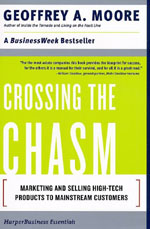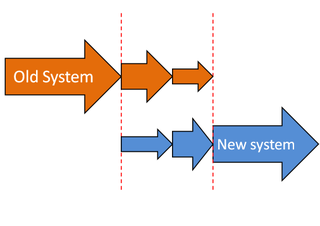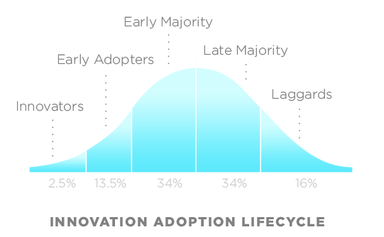
Innovation is the practical implementation of ideas that result in the introduction of new goods or services or improvement in offering goods or services. ISO TC 279 in the standard ISO 56000:2020 defines innovation as "a new or changed entity, realizing or redistributing value". Others have different definitions; a common element in the definitions is a focus on newness, improvement, and spread of ideas or technologies.
New product development (NPD) or product development in business and engineering covers the complete process of launching a new product to the market. Product development also includes the renewal of an existing product and introducing a product into a new market. A central aspect of NPD is product design. New product development is the realization of a market opportunity by making a product available for purchase. The products developed by an commercial organisation provide the means to generate income.
In business, diffusion is the process by which a new idea or new product is accepted by the market. The rate of diffusion is the speed with which the new idea spreads from one consumer to the next. Adoption is the reciprocal process as viewed from a consumer perspective rather than distributor; it is similar to diffusion except that it deals with the psychological processes an individual goes through, rather than an aggregate market process.

Crossing the Chasm: Marketing and Selling High-Tech Products to Mainstream Customers or simply Crossing the Chasm, is a marketing book by Geoffrey A. Moore that examines the market dynamics faced by innovative new products, with a particular focus on the "chasm" or adoption gap that lies between early and mainstream markets.

Proof of concept, also known as proof of principle, is a realization of a certain idea, method or principle in order to demonstrate its feasibility, or viability, or a demonstration in principle with the aim of verifying that some concept or theory has practical potential. A proof of concept is usually small and may or may not be complete.
Commercialisation or commercialization is the process of introducing a new product or production method into commerce—making it available on the market. The term often connotes especially entry into the mass market, but it also includes a move from the laboratory into commerce. Many technologies begin in a research and development laboratory or in an inventor's workshop and may not be practical for commercial use in their infancy. The "development" segment of the "research and development" spectrum requires time and money as systems are engineered with a view to making the product or method a paying commercial proposition.
Everett M. "Ev" Rogers was an American communication theorist and sociologist, who originated the diffusion of innovations theory and introduced the term early adopter. He was distinguished professor emeritus in the department of communication and journalism at the University of New Mexico.

Diffusion of innovations is a theory that seeks to explain how, why, and at what rate new ideas and technology spread. The theory was popularized by Everett Rogers in his book Diffusion of Innovations, first published in 1962. Rogers argues that diffusion is the process by which an innovation is communicated through certain channels over time among the participants in a social system. The origins of the diffusion of innovations theory are varied and span multiple disciplines.
Technological change (TC) or technological development is the overall process of invention, innovation and diffusion of technology or processes. In essence, technological change covers the invention of technologies and their commercialization or release as open source via research and development, the continual improvement of technologies, and the diffusion of technologies throughout industry or society. In short, technological change is based on both better and more technology.

Phased adoption or phased implementation is a strategy of implementing an innovation in an organization in a phased way, so that different parts of the organization are implemented in different subsequent time slots. Phased implementation is a method of System Changeover from an existing system to a new one that takes place in stages. Other concepts that are used are: phased conversion, phased approach, phased strategy, phased introduction and staged conversion. Other methods of system changeover include direct changeover and parallel running.
In computing, adoption means the transfer (conversion) between an old system and a target system in an organization.
Knowledge-Centered Service is a service delivery method that focuses on knowledge as a key asset of the organization implementing it. Development began in 1992 by the Consortium for Service Innovation, a non-profit alliance of service organizations. Its methodology is to integrate use of a knowledge base into the workflow.

The technology adoption lifecycle is a sociological model that describes the adoption or acceptance of a new product or innovation, according to the demographic and psychological characteristics of defined adopter groups. The process of adoption over time is typically illustrated as a classical normal distribution or "bell curve". The model calls the first group of people to use a new product "innovators", followed by "early adopters". Next come the "early majority" and "late majority", and the last group to eventually adopt a product are called "laggards" or "phobics". For example, a phobic may only use a cloud service when it is the only remaining method of performing a required task, but the phobic may not have an in-depth technical knowledge of how to use the service.

Eco-innovation is the development of products and processes that contribute to sustainable development, applying the commercial application of knowledge to elicit direct or indirect ecological improvements. This includes a range of related ideas, from environmentally friendly technological advances to socially acceptable innovative paths towards sustainability. The field of research that seeks to explain how, why, and at what rate new "ecological" ideas and technology spread is called eco-innovation diffusion.

The technology life cycle (TLC) describes the commercial gain of a product through the expense of research and development phase, and the financial return during its "vital life". Some technologies, such as steel, paper or cement manufacturing, have a long lifespan while in other cases, such as electronic or pharmaceutical products, the lifespan may be quite short.
A skunkworks project is a project developed by a relatively small and loosely structured group of people, generally within a larger organization such as a corporation, who research and develop a project, often with a very large degree of autonomy, primarily for the sake of radical innovation. The term originated with Lockheed's World War II Skunk Works project.

A push-button telephone is a telephone that has buttons or keys for dialing a telephone number, in contrast to a rotary dial used in earlier telephones.
CIPURSE is an open security standard for transit fare collection systems. It makes use of smart card technologies and additional security measures.
The sociological theory of diffusion is the study of the diffusion of innovations throughout social groups and organizations. The topic has seen rapid growth since the 1990s, reflecting curiosity about the process of social change and "fueled by interest in institutional arguments and in network and dynamic analysis." The theory uses a case study of the growth of business computing to explain different mechanisms of diffusion.
Customer success, also known as customer success management or client advocacy, is a business strategy focused on helping customers achieve their goals when using a product or service. It involves providing support and guidance to ensure customers get value from their investments. This approach aims to reduce customer churn and create opportunities for additional sales. As a specialized form of customer relationship management, customer success management focuses on implementing strategies that result in reduced customer churn and increased up-sell opportunities.









